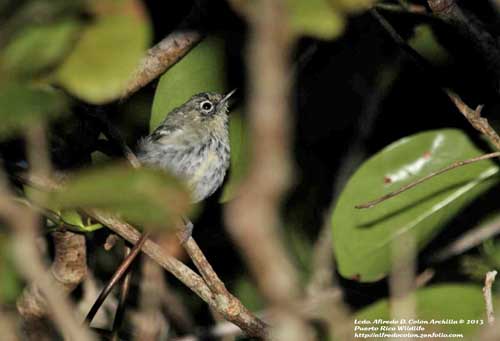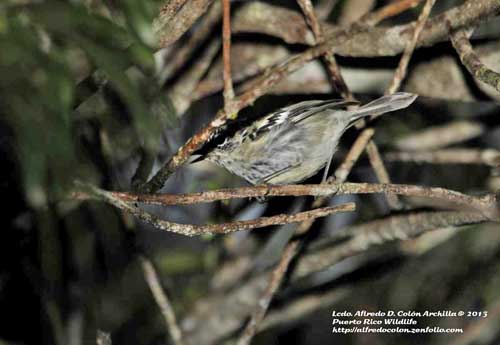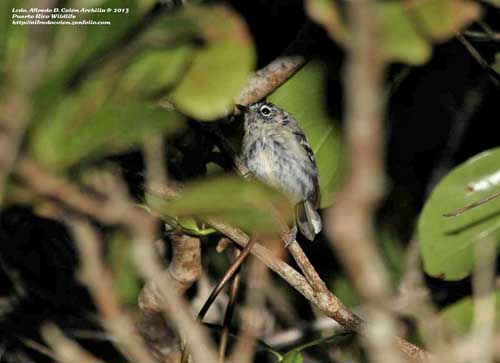
Fr: Paruline d’Angela
All: Angelawaldsänger
Esp: Chipe Duende, Reinita de Ángela, Reinita de Bosque Enano
Ital: Dendroica dei Boschi di Elfin
Nd: Puerto-Ricozanger
Sd: Bergskogssångare
Photographer:
Alfredo Colón
Puerto Rico Wildlife
Text by Nicole Bouglouan
Sources:
HANDBOOK OF THE BIRDS OF THE WORLD Vol 15 by Josep del Hoyo-Andrew Elliot-David Christie - Lynx Edicions – ISBN: 9788496553682
BirdLife International (BirdLife International)
Neotropical Birds – Cornell Lab of Ornithology
Wikipedia, the free encyclopaedia
Elfin-woods Warbler
Setophaga angelae
Passeriforme Order – Parulidae Family
INTRODUCTION:
The Elfin-woods Warbler is a rare endemic species to Puerto Rico. Its name pays tribute to Angela Kepler, born in 1943, naturalist and author from New Zealand. She is one of the discoverers of this species observed for the first time in 1968. It was discovered from the elfin or dwarf forest type of the Caribbean National Forest, in the Luquillo Mountains, in Puerto Rico, and it was described by Kepler and Parkes in 1972.
DESCRIPTION OF THE BIRD:
Biometrics:
Length: 12 cm
Weight: 8, 4 g
The Elfin-woods Warbler is a black and white small warbler. Is has a thin, white eyebrow stripe, white patches on ear coverts and neck, two whitish crescents as eye ring, white lores and black crown and cheeks.
It has exceptionally short, rounded black wings, with two white wing bars.
The upperparts are black with slight bluish gloss. Upper tail coverts are black with white margins.
The underparts are white, heavily spotted with black triangular marks, forming streaks from throat to belly.
The bill is dark grey, almost blackish. The eyes are dark brown. Legs and feet are bluish grey.
Both sexes are similar, but the male may have heavier streaking below than female.
The immature is similar to adult, but it has greyish-green on back instead black, and yellowish-green on the head and underparts.

RANGE:
The Elfin-woods Warbler is endemic to Puerto Rico, where it is uncommon with local distribution.
HABITAT:
The Elfin-woods Warbler frequents the dense vines of the forest canopy in tropical rainforest and lower mountainous zones. At first, it was found at higher elevations, but it has since been found between 370 and 1030 metres.
CALLS AND SONGS: SOUNDS BY XENO-CANTO
The Elfin-woods Warbler’s song is a series of short, rapid, unmusical notes on one pitch, increasing in volume, and with a short series of double notes slightly lower in pitch at the end.
The common call is a single, short, metallic “chip”. The contact call resembles song but without the double-note at the end.
BEHAVIOUR IN THE WILD:
The Elfin-woods Warbler feeds on insects. This species forages high in trees. It gleans insects from leaves in the outer part of the tree top. This is a very active bird. It often forages in mixed-species flocks outside the breeding season. It sometimes performs sally-hovering from foliage to glean an insect off the leaf, but rarely catches a prey in mid-air.

The Elfin-woods Warbler is territorial and defends its territory through songs. The courtship displays are not very well known, but like in numerous Parulidae species, short chases are observed with the male pursuing the female prior to copulation. Other displays enhance the contrasted plumage pattern with spread wings and tail in front of the female.
The nest is in a concealed location to reduce exposure to predators, and to protect the entrance from sun and rain. Some dry leaves (Cecropia) provide cover for the nest. This species is monogamous.
The result of different studies suggests that Elfin-woods Warbler performs altitudinal movements towards north facing valleys during the most of heaviest rainfall. But this warbler is resident in Puerto Rico.
The Elfin-wood Warbler often travels in mixed-species flocks. But the short rounded wings indicate a resident species.
REPRODUCTION OF THIS SPECIES:
The breeding season occurs between March and June, with the egg laying in April.
The nest is a compact cup, usually built close to the trunk, and well concealed in the foliage growing on the trunk, at about 1, 50-7 metres above the ground. This structure is a tightly woven cup made with fine plant fibres and some dry leaves outside. It is lined with fine plant materials, vegetal down and some feathers.
The female lays 3-4 dull white eggs, spotted with reddish-brown. No information about incubation and fledging periods.
The chicks are fed by both parents with insects (arthropods). The parents utter a “chip” when arriving at nest. The adults approach furtively, making circles around the tree stump, and then, they fly to the rim before to enter into the cavity.
Each parent waits for the other, remaining in the area a few moments, in close proximity to each other, and sometimes, singing.

PROTECTION / THREATS / STATUS:
The Elfin-woods Warbler has some predators such as the Sharp-shinned Hawk (Accipiter striatus) and the Pearly-eyed Thrasher (Margarops fuscatus), and endemic species snakes. Small mammals such as cats, dogs and rats, are potential predators too.
Habitat loss due to human activities is a threat for this species, by reducing available wildlife areas. The global population includes about 1830 individuals in two main populations, now quite isolated from each other by new roads.
This species is currently evaluated as Vulnerable, due to the small population and the very restricted range, making this warbler vulnerable to natural weather conditions such as hurricanes.